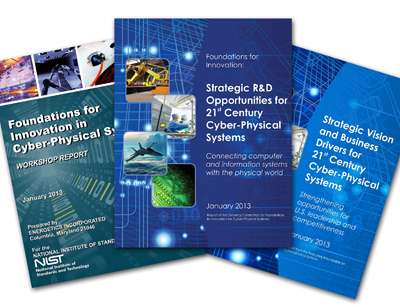New reports define strategic vision, propose R&D priorities for future cyber-physical systems

If designed and built efficiently, flexibly and securely, next-generation cyber-physical systems (CPS) now sprouting from interconnections that join the digital and engineered physical worlds will deliver extraordinary capabilities and tremendous benefits on scales ranging from individuals to organizations and from industries to national and global economies.
Three new reports prepared for the National Institute of Standards and Technology (NIST) distill the perspectives of executives and technical experts from industry, academia and government on the "ifs" and the "what's next" of emerging intelligent systems-of-systems technologies. Complex technical, institutional and societal challenges notwithstanding, future CPS could have sweeping impacts on how we live, work and do business, according to the reports.
"CPS are enabling a new generation of 'smart systems'—and the economic impacts could be enormous," explains the summary report of a NIST-organized roundtable of industry and government executives and university leaders. "The disruptive technologies emerging from combining the cyber and physical worlds could provide an innovation engine for a broad range of U.S. industries, creating entirely new markets and platforms for growth."
CPS go well beyond today's "embedded systems," which are largely task-specific machines that operate under computer control. Anticipated CPS uses such as intelligent vehicles and highways and next-generation air transportation will be significantly more ambitious, diverse and integrated than those of today's task-specialized embedded systems.
The broad sweep of anticipated CPS uses is suggested by a variety of other labels inspired by the convergence of networking and information processing technologies with engineered physical systems. Together, they create systems that integrate distributed networks of sensors, controls and processors—for example, "internet of things," "industrial internet" and "smarter planet."
The good news, according to the experts assembled by NIST, is that the United States, as the world leader in cutting-edge cyber technologies and engineered physical systems, is well-positioned to reap the competitive advantages of developing and mastering advanced CPS. But other nations are not conceding these advantages.
The European Union, for example, plans to invest $7 billion on embedded systems and CPS, with the aim of becoming a global leader in the field by 2020. Japan, which currently hosts the world's largest tradeshow on embedded systems, has similar ambitions.
Developed with input from about 80 experts in CPS and related technologies, the new reports provide a strategic vision and business drivers motivating concerted public-private efforts to achieve the unprecedented capabilities of next-generation CPS within the next two decades. They also provide a multilayered view of the research and development challenges that must be solved to realize this potential. Sectors singled out to illustrate both the promise of anticipated CPS applications and obstacles that stand in the way include smart manufacturing, smart utilities, smart buildings and infrastructure, and smart transportation and mobility.
Transcending challenges and needs include cybersecurity, technology platforms with integrated architectures, interoperability standards, communication protocols, performance and quality assurance systems, seamless human-CPS interactions and education and workforce training.
The three reports are:
- Strategic R&D Opportunities for 21st Century Cyber-Physical Systems: provides a high-level perspective on key challenges and research opportunities for advancing CPS; intended to inform decisions about the technology R&D that should be pursued. Available at www.nist.gov/el/upload/12-Cybe … tems020113_final.pdf.
- Strategic Vision and Business Drivers for 21st Century Cyber-Physical Systems: summarizes the ideas generated during an executive roundtable attended by business and technical leaders, representing a spectrum of applications for CPS, from medicine to energy to manufacturing. Available at www.nist.gov/el/upload/Exec-Ro … rt-Final-1-30-13.pdf.
- Foundations for Innovation in Cyber-Physical Systems: summarizes the results of a workshop where scientists and engineers identified and prioritized technical barriers—including measurement science and standards-related needs—that impede progress. Available at www.nist.gov/el/upload/CPS-Wor … rt-1-30-13-Final.pdf.
Provided by National Institute of Standards and Technology
















